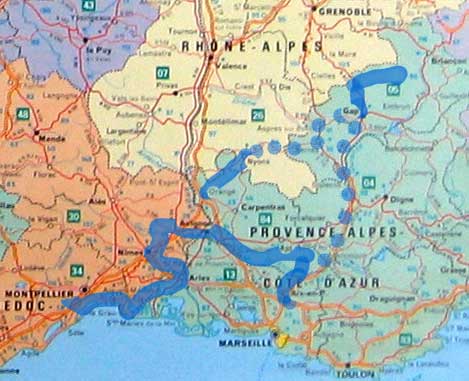
The European Bike Express took us and our tandem from London to Montpellier on July 2nd and picked us up from Orange on July 22nd and returned us to London. In the first week we travelled through the Camargue and Provence, then via the Alpilles to the Luberon where we spent the second week in a gite and toured the area without our luggage.
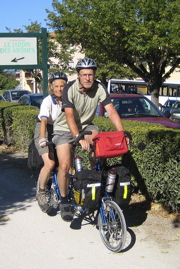 This year we used our new Moulton tandem (described in detail here) and found the easy step-through mounting very convenient and the suspension made it very comfortable. In addition, it was just as robust, manoeuvrable and able to go up (and down) hills as our previous Dawes Galaxy. The third advantage of this tandem is its ability to separate into three parts, which enabled us to be given a lift in a car to the Hautes Alpes where we spent our third week with friends Xavier and Claudine and their extended family.
This year we used our new Moulton tandem (described in detail here) and found the easy step-through mounting very convenient and the suspension made it very comfortable. In addition, it was just as robust, manoeuvrable and able to go up (and down) hills as our previous Dawes Galaxy. The third advantage of this tandem is its ability to separate into three parts, which enabled us to be given a lift in a car to the Hautes Alpes where we spent our third week with friends Xavier and Claudine and their extended family.
We had decided not to make our distances so great this time – we did do a little over 700 km. This was just as well as the temperatures were high (mid thirties most of the time). The movement of the bike generates a pleasant cooling breeze and with plenty of fluid intake we managed to complete our itinerary; but we decided that any future tours this far south should be done in May or September. Fortunately we were cooled a little by north winds - the Mistral in Provence and the Bise in the Alps.
As usual, we aimed to avoid Routes Nationales (N) roads altogether and roads marked in red on the map as far as possible. We have provided some details of roads followed each day in case others want to follow the route.
We took the European Bike Express from South Mimms, leaving at 11 am and getting to Montpellier about 8.30 am the next day. As usual the staff were very friendly and helpful. We had a convenient stop at a services enabling us to taste our first french food. We were lucky in being able to move to the table seats when other cyclists were dropped at Auxerre and were able to sleep with our legs fully extended.
Click any photo in the diary to see an enlargement.
Our other photographs of les Saintes Maries de la Mer are here.
The drop-off point is outside the Macdonalds at St. Jean de Vidas to the south-west of Montpellier. At first we were disappointed that Macdonalds was closed as we wanted a toilet and some breakfast, but then we found the Campanile hotel where we had a welcome wash and an excellent buffet breakfast and lots of strong coffee to wake us up well worth the 8 Euros charged, especially with the extra fruit we snaffled from the buffet! We were ready to go by 9.50 and realised immediately that it was a very hot day.
We had some initial trouble finding the right direction,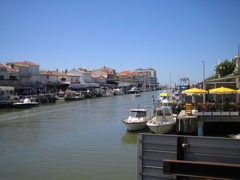 but were soon down to the coast and cycling along with the Mediterranean on one side and the big étangs on the other side. As usual by the seaside, it was a case of dodging between holiday makers on foot, trying to park cars and occasionally wobbling along on bikes. La Motte is a resort with very strange 1960s concrete architecture, but well laid out with large car-free areas. Le Grau de Roi (picture right) is a very attractive place where one of the branches of the Rhone reaches the sea.
but were soon down to the coast and cycling along with the Mediterranean on one side and the big étangs on the other side. As usual by the seaside, it was a case of dodging between holiday makers on foot, trying to park cars and occasionally wobbling along on bikes. La Motte is a resort with very strange 1960s concrete architecture, but well laid out with large car-free areas. Le Grau de Roi (picture right) is a very attractive place where one of the branches of the Rhone reaches the sea.
We followed t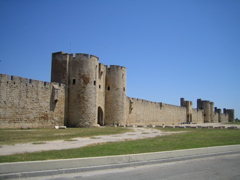 he river inland, where we spotted our first flamingo and then stopped for a picnic lunch inside the walls of Aigues Mortes. This walled town was built by Louis IX at the time of the crusades. The walls form a rectangle, with gates on each side leading to a square in the centre. We cycled through the streets to remind ourselves of the attractions of this little town in which we had spent more time five years ago. The town is next to a big étang where salt manufacture takes place - the white heaps of salt are beautiful against the blue sky.
he river inland, where we spotted our first flamingo and then stopped for a picnic lunch inside the walls of Aigues Mortes. This walled town was built by Louis IX at the time of the crusades. The walls form a rectangle, with gates on each side leading to a square in the centre. We cycled through the streets to remind ourselves of the attractions of this little town in which we had spent more time five years ago. The town is next to a big étang where salt manufacture takes place - the white heaps of salt are beautiful against the blue sky.
The little road from Aigues Mortes borders a big étang and then crosses another river - the Little Rhone. These many branches of the Rhone form the Bouches du Rhone which define a large marshy area known as the Camargue. We followed the Little Rhone to the coast at Port Gardien and then went along the coast to Les Saintes-Maries-de-la-Mer.
We had booked into the Hotel Mediterranée which is a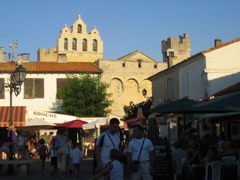 very pretty family run hotel with flowers and a garden. It was a good choice, in the main street – not on the coast road. We immedately had a refreshing swim in the sea. Les Saintes-Maries-de-la-Mer is a very pleasant resort - the charactersitic that we noted most was quietness - most of the streets are pedestrianised. There is an old 12th century fortified church with barrell vault and crypt; the church is full of ex-votos - the end above the crypt is reserved for praying but the remainder is for tourists.
very pretty family run hotel with flowers and a garden. It was a good choice, in the main street – not on the coast road. We immedately had a refreshing swim in the sea. Les Saintes-Maries-de-la-Mer is a very pleasant resort - the charactersitic that we noted most was quietness - most of the streets are pedestrianised. There is an old 12th century fortified church with barrell vault and crypt; the church is full of ex-votos - the end above the crypt is reserved for praying but the remainder is for tourists.
Hotel. Mediterranée. Stes Maries-de-la-Mar. 04 90 97 82 09.
Today's distance 78 km. Route details - Monpellier – Palavas-les-Flots – Carnon – La Grande Motte – le-Grau-de Roi – Aigues Mortes – (D34 and D38) – Port Gardian – Satinte-Maries-de-la-Mer.
Our photographs of the Camargue and Arles are available here.
This was an overcast day - the only one with rain apart from a brief but drenching thunderstorm the following week at La Tour d'Aigues, but no need for waterproofs. After a nice breakfast at the Hotel Mediterranée, we tried to cycle on the Digue-de-la-Mer which goes between the Etang and the sea eastwards, but after a short distance we became bogged down in sand and decided to give up - we can't understand why it is recommended for cycling.
We left the town on a back road in the direction of Arles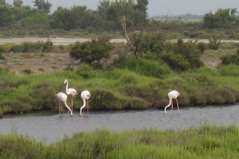 and saw flamingoes, white herons, a storks nest and then stopped at the Musée de la Camargue, where we learned all about the cultivation of rice in the Camargue which started in 16th century and became very important after
and saw flamingoes, white herons, a storks nest and then stopped at the Musée de la Camargue, where we learned all about the cultivation of rice in the Camargue which started in 16th century and became very important after  WW2. On the route we passed many rice fields, which are a deep green colour and when you look carefully, they are deep in water. Our next stop was at the Maison de la Camargue, a nice old long barn which is used as a centre for telling about life through the ages in the Camargue area. Then as we rode along towards Arles, we saw many of the white horses and black bulls which together with the flamingoes are what the Camargue is known for. Originally the horses and bulls would have been wild, but now they appear to be domesticated, particularly the latter.
WW2. On the route we passed many rice fields, which are a deep green colour and when you look carefully, they are deep in water. Our next stop was at the Maison de la Camargue, a nice old long barn which is used as a centre for telling about life through the ages in the Camargue area. Then as we rode along towards Arles, we saw many of the white horses and black bulls which together with the flamingoes are what the Camargue is known for. Originally the horses and bulls would have been wild, but now they appear to be domesticated, particularly the latter.
The route into Arles from the west over the Rhone is very convenient - you arrive right in the town. We stopped at Hotel de la Poste which offered a place for the tandem, although in the end, we couldn't get it into the cellar and had to lock it up in the garden. We had a picnic lunch in the Roman theatre, which is rather spoilt by scaffolding and then we went in search of the Roman amphitheatre. 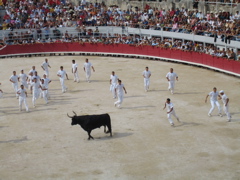 When we got there, we discovered that a show called Cocade d'Or was to be on that evening and after making enquiries, decided to book in to see it. While waiting for the show in a café, we met a very friendly photographer from Montpellier who told us about the show which is a very active local tradition. The show commenced with a procession of women in Arlesienne dress and then the 'tauromachie' or 'courses Camargaises' started. A black bull was let into the ring and the about 50 men in white joined it. The bull had strings on its horns and the task for the men was to get a string and jump over the barrier before the bull got them. It was exciting to sit in the amphitheatre like a Roman, but after a couple of hours we found the show rather repetitive and left early. Our Montpellier friend had explained to us that bull running was a strong tradition in the whole area and took place more informally in the streets of most villages during the summer. His work involved photographing these as well as mountain scenes for publication in the many magazines dealing with outdoor activities published in France. We didn't encounter any other bull running, but we saw the warning signs for visitors in several of the villages we passed through.
When we got there, we discovered that a show called Cocade d'Or was to be on that evening and after making enquiries, decided to book in to see it. While waiting for the show in a café, we met a very friendly photographer from Montpellier who told us about the show which is a very active local tradition. The show commenced with a procession of women in Arlesienne dress and then the 'tauromachie' or 'courses Camargaises' started. A black bull was let into the ring and the about 50 men in white joined it. The bull had strings on its horns and the task for the men was to get a string and jump over the barrier before the bull got them. It was exciting to sit in the amphitheatre like a Roman, but after a couple of hours we found the show rather repetitive and left early. Our Montpellier friend had explained to us that bull running was a strong tradition in the whole area and took place more informally in the streets of most villages during the summer. His work involved photographing these as well as mountain scenes for publication in the many magazines dealing with outdoor activities published in France. We didn't encounter any other bull running, but we saw the warning signs for visitors in several of the villages we passed through.
That night, all the restaurants were offering 'Grand Aioli' which George tried, but Jean had penne with cepes as she's not partial to mayonnaise.
Hotel : Hotel de la Poste.
Distance today 53 kms. Route details- les Saintes-Maries-de-la-Mer via D570 to Maison du Parc and into Arles via Gimeaux.
Our photographs of Nîmes are available here.
This was a fine, bright day, but with a strong wind from the north - we rode aginst it some of the way, but it did cool us. We left Arles over the bridge and then followed a cycle track via St. Gilles and Generac. We moved from the flat lands of the Bouches du Rhone, over the Little Rhone and through the Costieres de Nîmes vineyards. We picnicked by a little river and then went into Nîmes through some nasty suburbs, but arrived accurately by by the amphitheatre.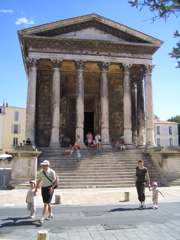 We had been hoping to stay in a little hotel nearby, but they were full up as Verdi's Aida was being performed that night in the amphitheatre. They directed us via some narrow pedestrianised streets to the Tourist Office which is right by the Maison Carré - a perfectly preserved Roman temple from the first century AD. Opposite the Maison Carre is Norman Foster's Carre d'Art - a gallery and library with views of the roman temple.
We had been hoping to stay in a little hotel nearby, but they were full up as Verdi's Aida was being performed that night in the amphitheatre. They directed us via some narrow pedestrianised streets to the Tourist Office which is right by the Maison Carré - a perfectly preserved Roman temple from the first century AD. Opposite the Maison Carre is Norman Foster's Carre d'Art - a gallery and library with views of the roman temple.
We settled in the hotel recommended by the tourist office, then ventured out to book tickets for Aïda, to see Justinian's gate and to rest in the gardens above the big fountain. These gardens are classically laid out and provide a distant view down the road.
The tickets €40 allowed us to sit 'anywhere' which involved queuing up and then racing in to try to get a good position. We then sat and ate a picnic while we waited for the performance to start at 9.30. Once again, it was exciting to watch this performance in a Roman ampthitheatre, although we were a long way from the stage.
involved queuing up and then racing in to try to get a good position. We then sat and ate a picnic while we waited for the performance to start at 9.30. Once again, it was exciting to watch this performance in a Roman ampthitheatre, although we were a long way from the stage.
Hotel : Hotel d'Acanthe du Temple.
Distance today 43 kms. Route details- Leave Arles to Grimeaux -– on cycle route to St-Gilles – Generac – Nîmes.
Our photographs of the Pont du Gard and Avignon are available here.
A very hot day. We left Nîmes up a long hill, through a military firing range in very attractive country and eventually reached the gorge of Gardons, crossing the river by a former priory.
Although we were cycling p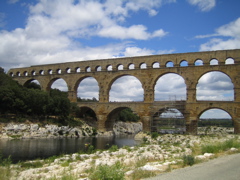 arallel to the gorges, we were on a flat road running through pretty vineyards all the way to Pont-du-Gard. The vehicles have to park on either of the banks but pedestrians and cyclists can go right in and over the old Roman bridge. The surrounding area is rather over institutionalised with cafes, information points, but I suppose it is excusable considering the number of tourists that visit the site. Anyway, its is good to keep the cars well at bay. It was very inspiring to see this beautiful old three-level Roman aqueduct which is part of a channel over 50 km long taking water from springs in Uzès to the Roman town in Nîmes, apparently with a drop of only 17 metres.
arallel to the gorges, we were on a flat road running through pretty vineyards all the way to Pont-du-Gard. The vehicles have to park on either of the banks but pedestrians and cyclists can go right in and over the old Roman bridge. The surrounding area is rather over institutionalised with cafes, information points, but I suppose it is excusable considering the number of tourists that visit the site. Anyway, its is good to keep the cars well at bay. It was very inspiring to see this beautiful old three-level Roman aqueduct which is part of a channel over 50 km long taking water from springs in Uzès to the Roman town in Nîmes, apparently with a drop of only 17 metres.
Having picnicked while we admired the aqueduct, we then cycled over it and set off on our way to Avignon. We had hoped to follow the Rhone into Avignon from Aramon, crossing the Rhone directly into the town. But although this road was marked as picturesque and was only a D road, there were too many HGVs so we took the first bridge over the river and found a tiny track (formerly a main road) that ran through the fields alongside the river and then by the Durance that flows into the Rhone at this point. This eventually involved crossing the Durance and entering Avignon via the southern suburbs. The Durance bridges are problematic for cyclists - they are not wide enough for vehicles to overtake cyclists - this one we crossed on the footway.
We eventually booked into a hotel on the main street by about 5 pm.
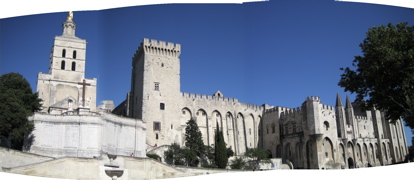 We were absolutely overcome by the heat, so sat in Place de l'Horloge for a quiet drink and cool off. This square is named after the town hall whose tower has the clock. As it cooled off, we walked round the outside of the Popes' Palace and then on and up into the on Rocher du Doms with a view over the river Rhone and the famous Pont d'Avignon as well as Villeneuve opposite. Then we went down to make the visit to the bridge and learned of its construction in 11th century by monk Benezet and its eventual gradual destruction b
We were absolutely overcome by the heat, so sat in Place de l'Horloge for a quiet drink and cool off. This square is named after the town hall whose tower has the clock. As it cooled off, we walked round the outside of the Popes' Palace and then on and up into the on Rocher du Doms with a view over the river Rhone and the famous Pont d'Avignon as well as Villeneuve opposite. Then we went down to make the visit to the bridge and learned of its construction in 11th century by monk Benezet and its eventual gradual destruction b y floods. The last big flood was in the 1950s and then the dams were constructed.
y floods. The last big flood was in the 1950s and then the dams were constructed.
We had an interesting meal at la Vache à Carreaux which serves meals mainly based on cheese in an old stone-walled dining room. The owner advises on choice of wine. We had big plate of charcuterie and cheese with Domaine Murmacien - Vaucluse 2004. Then we wondered round the squares and watched the entertainers.
Hotel : Hotel Danieli.
Distance today 72 kms. Route details- leave Nîmes on north side (D979) as far as former Priory then cross Gardons and follow parallel to the river to Pont du Gard (left bank), cross the pont – Remoulins –Theziers - Aramon (cross Rhone) – tracks by river then right along Durance – Rognonas – into Avignon from south.
We spent the morning in Avignon as we had only a short ride ahead of us. First we went around the Popes Palace. We wondered what the popes were doing in Avignon - they lived there for about 60 years in the 13th century and built two palaces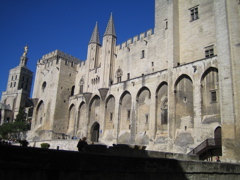 there. Although there were panels explaining the history of the popes troubles, it wasn't really clear why they couldn't stay in their palaces in Rome. Anyway, the buildings they made in Avignon are great - the old palace being more austere with wings, cloister and a big tower; and the new one which was extensively decorated by Matteo Giovanetti and others.
there. Although there were panels explaining the history of the popes troubles, it wasn't really clear why they couldn't stay in their palaces in Rome. Anyway, the buildings they made in Avignon are great - the old palace being more austere with wings, cloister and a big tower; and the new one which was extensively decorated by Matteo Giovanetti and others.
The Petit Palais houses a very extensive collection of early italian paintings. The collection was made by an italian count who was eventually jailed for not paying his debts. Napoleon 3 bought the bankrupt stock for galleries in France and they are here. The collection contains excellent examples of 12th - 14th century paintings from Siena, Florence and a style called international gothic.
Then we received a text message from George's daughter asking whether we were 'safe and sound'. We didn't know why we shouldn't be and didn't at first try to find out apart from texting back to ask what had happened and asking in the hotel as we departed whether they had any news from London. In retrospect, we should have gone to an internet cafe and read the news. It wasn't until we eventually spoke to the host at the B and B that night that we heard anything about the four bombs in London. She let us borrow a TV but we couldn't find a news program until much later. Meanwhile we started texting family in London and eventually got through to a real phone to speak to Jean's daughter at about 5.30 who reassured us that all were safe and sound.
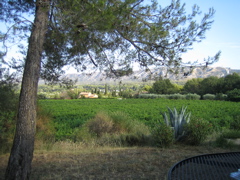 In the afternoon we left Avignon for St. Remy-de-Provence. The B & B we had booked is about 2 km outside St.Remy de Provence to the north east – it is up a hill and quite hard to find, but well worth the effort. The room has a lovely view across fields of vines and olives to a view of the Alpilles. These hills are very attractive - being of very light grey stone and quite jagged. The room too is very special with a terrace with a table and inside the room and bathroom is spacious and lined with wood.
In the afternoon we left Avignon for St. Remy-de-Provence. The B & B we had booked is about 2 km outside St.Remy de Provence to the north east – it is up a hill and quite hard to find, but well worth the effort. The room has a lovely view across fields of vines and olives to a view of the Alpilles. These hills are very attractive - being of very light grey stone and quite jagged. The room too is very special with a terrace with a table and inside the room and bathroom is spacious and lined with wood.
As we wanted to watch the TV for news, our hostess very kindly took us to the supermarket to buy a cold meal and lent us plates etc.
Chambre d'hote Miriam Feige, 04 90 92 02 63. As described above - a very friendly hostess with lovely rooms, a magnificent view and in addition a big pool.
Distance today 25 kms. Route details - Leave Avignon via south and Rognonas - Graveson – Maillane – St. Remy de Provence
Our photographs of St. Remy, Glanum and les Baux de Provence are here.
We used the St. Remy B & B as a base and went off for the day without our baggage to visit Glanum and Les Baux-de-Provence. Glanum which is just to the north of St. Remy has been inhabited since before the Greeks started building there. Then the Romans came in the second century BC. The very extensive sloping site contains the remains of temples, baths and a forum.

The road past Glanum reaches Les Baux-de-Provence after a stiff climb. Lex Baux occupies a hilltop site - a bare rocky outcrop at the summit of a plateau on the Alpilles. The village has many narrow streets winding up and down the hillside and the buildings are often built partly from the rock beneath. The church is partly cut into the rock, has excellent modern stained glass and dates from various eras - Roman, gothic etc.
The castle (or citadelle) is the main attraction - 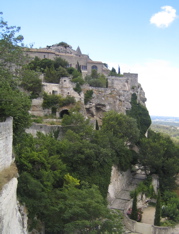 occupying the largest part of the plateau and consisting of a big Saracen tower and another tower offering good views of the village below. The panoramas from the castle keep and elsewhere in the grounds are stunning – the fields of vines and olives in their respective green and bright grey making patterns across the landscape.
occupying the largest part of the plateau and consisting of a big Saracen tower and another tower offering good views of the village below. The panoramas from the castle keep and elsewhere in the grounds are stunning – the fields of vines and olives in their respective green and bright grey making patterns across the landscape.
The Yves Bayer gallery houses the work of the eclectic 20th century artist of that name. The lithographs and tapestries were good – somewhere between Van Gogh and Cezanne. The oil paintings were not so pleasing. The top floor of the gallery had an exhibition of Picasso and Goya prints of bull fighting - well worth seeing.
The ride back to St. Remy on the minor road was lovely. First we had to climb a little further up the white stony Alpilles and then had a long run down on a very quiet road through beautiful landscape. One of the best roads of the trip. 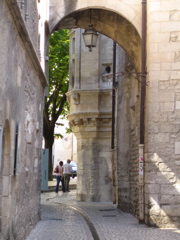
We explored the centre of St. Remy, noting the renaissance 'hotels' (large period houses). We then bought food for an evening meal - our terrace at the B & B was far too attractive to waste by going out to a restaurant. But before our meal, we had a swim in the big pool 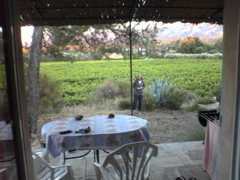 available in the garden. On chatting to the other guests we met people who liked the place so much that they had been several times before. Some of the rooms are let out as gites.
available in the garden. On chatting to the other guests we met people who liked the place so much that they had been several times before. Some of the rooms are let out as gites.
Chambre d'hotes Miriam Feige, 04 90 92 02 63
Distance today 24 kms. Route details - leave St.Remy (past tourist office) on D5 (past Glanum), turn onto D27 and up into Les Baux-de-Provence. Return via D27.
A long ride across to the far side of the Luberon where we had booked a gite for a week at la Tour-d'Aigues. Another very hot day, but with a very strong Mistral (north wind) which helped us more than delaying us and definitely cooled us a bit.
The Luberon is a range of small mountains between the Mediterranean and the Alps, bordered on the south side by the Durance. It is defined as a regional park and contains a collection of litle villages, many of them 'perched' on hilltops.
We rode along the north side of the Alpilles as far as the end at Orgon - using a cycle path at first and then a variety of side roads to keep off the too-busy N road. Orgon is a very attractive old town on the side of a hill with arches on entrance and exit. A helpful person at the tourist office told us how to find the little road beside the railway as far as Sénas. Somehow we managed to cross underneath the two big roads (A and N) and move towards Mallmort, but with some back-tracking. We were going through nice farmland, mostly vineyards and some olive trees. We had our picnic near to la Roque d'Anthéron, having just passed the Abbaye of Silvacane. After that we followed the Durance with its dams and HE plants, although not much water in it. Here we noticed that there were many apple and pear orchards. We managed to stay on small roads until just before the bridge over the Durance. The bridge was too narrow and we couldn't stop to look at the view - too dangerous with the traffic. Then up the hill, through the town of Pertuis and on to la Tour-d'Aigues.
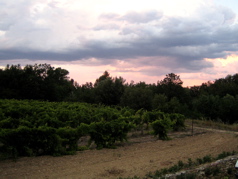 We found our gite in the middle of a vineyard without difficulty (a little way out of town), unpacked our bags and then went shopping in la Tour-d'Aigues. On our return the daughter of the owner and her husband and baby greeted us - saying their parents are away for a few days. The gite is basically one big room with a corner kitchen + bathroom + small bedroom. It has a lovely view over the vineyards and across to the mountains.
We found our gite in the middle of a vineyard without difficulty (a little way out of town), unpacked our bags and then went shopping in la Tour-d'Aigues. On our return the daughter of the owner and her husband and baby greeted us - saying their parents are away for a few days. The gite is basically one big room with a corner kitchen + bathroom + small bedroom. It has a lovely view over the vineyards and across to the mountains.
Gite : Jean-Louis Pascal, Le Bout du Parc, la Tour d'Aigues, 04 90 07 41 89. We stayed here until 16th July.
Distance today 84 kms. Route details - St.Remy (use cycle track and then small roads parallel to D99) – Eygalieres – Orgon – small road by railway – Senas – Malespine – Mallemort – Charleval – Silvacane – le Puy – cross Durance – Pertuis – la Tour-d'Aigues.
Our photographs of Mourre Negre are here.
Mourre Negre (black face) is the highest point of the Luberon and we could see it from our terrace. Therefore we decided to go and walk up it. This involved a short bike ride through the little old villages of St. Martin-de-la-Brasque, la Motte d'Aigues and Cabriere d'Aigues where we enquired about the GR and a rather bossy local told us we were not allowed to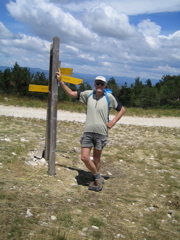 walk on the mountain after 11 am. Anyway, we locked the bike to a tree at the bottom of the footpath and started up the GR - we soon found the sign saying 'people are authorised to go on the mountain between 5 and 11 am'. But as it didn't say 'only' or anything about other times, we decided to go ahead.
walk on the mountain after 11 am. Anyway, we locked the bike to a tree at the bottom of the footpath and started up the GR - we soon found the sign saying 'people are authorised to go on the mountain between 5 and 11 am'. But as it didn't say 'only' or anything about other times, we decided to go ahead.
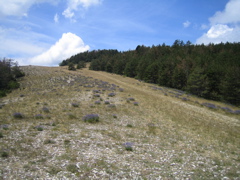 The GR 93 leads directly up the mountain to a plateau called Coteau des Garnates at 1072 m it is one of those beautiful clearings where you emerge from the trees onto a wide open area with views all round - in this case it was covered with lavender which was attracting hundreds of butterflies. We had our picnic under a small pine tree and then turned left up the ridge to Mourre Negre at 1125 m - although this is the top, it was spoilt by a communications tower and a track coming up from the other side. We walked all the way down, gradually getting hotter and hotter and running out of water, having taken only two of our bottles with us.
The GR 93 leads directly up the mountain to a plateau called Coteau des Garnates at 1072 m it is one of those beautiful clearings where you emerge from the trees onto a wide open area with views all round - in this case it was covered with lavender which was attracting hundreds of butterflies. We had our picnic under a small pine tree and then turned left up the ridge to Mourre Negre at 1125 m - although this is the top, it was spoilt by a communications tower and a track coming up from the other side. We walked all the way down, gradually getting hotter and hotter and running out of water, having taken only two of our bottles with us.
It was when we got back on the bike that we realised how much cooler it is on a bike, even when going slowly. But air cooling was inadequate so we headed to l'Etang de la Bonde where we took a quick swim in this big pool. It had to be quick as the weather changed very quickly, rain started to fall and thunder to rumble. We couldn't find adequate shelter by the lake so quickly dressed and got on the bike. All the way back to la Tour d'Aigues it poured really hard and there was plenty of thunder and lightening as we entered the town we found shelter under some arcardes by the Mairie. Of course we didn't have waterproofs and by now were shivering, so when the rain stopped we went into a bar for hot chocolate supplemented by a pastis and accompanied by a chocolatey thing called 'herisson' from the baker next door. Then when the rain stopped, back to the gite to change into something dry and make a meal, putting our wet shoes on the doorstep.
Our hosts had given us two giant aubergines and a big basket of french beans so we made parmigiana (an italian dish with layers of fried aubergines, tomato sauce and grated cheese) and bean salad.
Later on in the evening, the young man came to the door with Jean's shoes, explaining that the dog had taken them and hidden them – in addition it had chewed at the heels of both shoes, one of them quite badly.
Distance today 22 kms. Route details - D91 St Martin -de-la-Brasque – la Motte d'Aigues – Cabrieres d'Aigues. Walk on GR 92 to Mourre Negre and down – cycle via Etang de la Borde to la Tour-d'Aigues.
Our photographs of Grambois and Mirabeau are here.
 A short ride by bike to see two of the nearby perched villages (Grambois and Mirabeau) and to take a short walk by the Durance at the bridge of Mirabeau.
A short ride by bike to see two of the nearby perched villages (Grambois and Mirabeau) and to take a short walk by the Durance at the bridge of Mirabeau.
Grambois is a walled village on the slopes at the top of a hill with old houses and a fortified church. Inside the church is a beautiful tryptych painted by a painter from Aix in 1512. (it was labelled tryptych, but actually had five panels, the two on each side being divided in two). Outside the church is an attractive square surrounded by old houses.
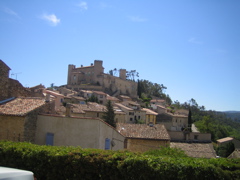 An enormous hill must be climbed between Grambois and Mirabeau. Mirabeau is a small town with several squares, the main one being by a fountain – where our host's daughter and her husband are doing up an old house. We bought a Guardian (why would a small shop in this small village have a Guardian?), sat in a bar and cooled off. The church was locked and the chateau private, so we didn't visit either.
An enormous hill must be climbed between Grambois and Mirabeau. Mirabeau is a small town with several squares, the main one being by a fountain – where our host's daughter and her husband are doing up an old house. We bought a Guardian (why would a small shop in this small village have a Guardian?), sat in a bar and cooled off. The church was locked and the chateau private, so we didn't visit either.
We had a gentle coast down the hill to the river Durance by the bridge of Mirabeau. To the east, the river passes through the narrow gorges of Mirabeau. We took a short walk along the bank to the west, passing the remains of the much more elegant old bridge which bore what looked like many shell holes, presumably it was destroyed in WW2. 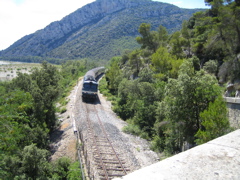
The new bridge is rather plain. The railway runs between the path and the river - the latter consisting of a wide dry bed with a narrow river flowing through it. It was very hot and humid down here - we stopped and watched some rock climbers toiling up an almost vertical rock. The view across the river was spoiled by the N and A roads on the other side.
On the return we stopped in la Tour d'Aigues - we hadn't yet taken in the town at all.  In particular there is a very fine ruined renaissance chateau with a giant square in front of it. Below the square and chateau is a very deep drop to the little stream below. From the square is a long panorama of the surrounding lanscape.
In particular there is a very fine ruined renaissance chateau with a giant square in front of it. Below the square and chateau is a very deep drop to the little stream below. From the square is a long panorama of the surrounding lanscape.
Our photographs of Grambois and Mirabelle are available here.
Distance today 33 kms. Route details - la Tour-d'Aigues – Grambois – Mirabeau – Pont de Mirabeau – return via D973 and D246.
Our photos of Aix-en-Provence are here.
We left the gite to spend two nights in Aix-en-Provence hoping to take in Mont Ste Victoire as well. 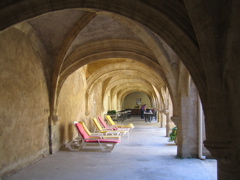 On the way, we used the road through Pertuis and the same horrible narrow bridge over the Durance. We had read in the Green Guide about Hotel le Manoir at Aix and looked out for signs on the way into town, managing to go straight to the entrance. Luckily for us they had a room for one night and allowed us to park the tandem at the end of their cloisters - the hotel had been a hat factory and a convent, then a woman bought it and made a student hostel, but in 1968 after the student demos she decided to convert it to a hotel. The adjacent cloistered terrace was much older - 14th century - a lovely place to have breakfast.
On the way, we used the road through Pertuis and the same horrible narrow bridge over the Durance. We had read in the Green Guide about Hotel le Manoir at Aix and looked out for signs on the way into town, managing to go straight to the entrance. Luckily for us they had a room for one night and allowed us to park the tandem at the end of their cloisters - the hotel had been a hat factory and a convent, then a woman bought it and made a student hostel, but in 1968 after the student demos she decided to convert it to a hotel. The adjacent cloistered terrace was much older - 14th century - a lovely place to have breakfast.
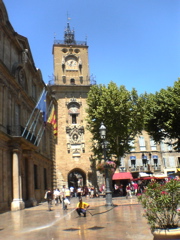 It was a short walk through narrow car-free streets to the main square by the town hall where a flower market was just closing down. The town hall is a magnificent renaissance building with a clock tower and decorative metal work. You can look inside the courtyard with its paved terrace and pillared buildings. After lunch we found a hiking shop just opposite the cathedral with some nice 'rando' shoes at reduced price which Jean bought to replace the dog-eaten ones.
It was a short walk through narrow car-free streets to the main square by the town hall where a flower market was just closing down. The town hall is a magnificent renaissance building with a clock tower and decorative metal work. You can look inside the courtyard with its paved terrace and pillared buildings. After lunch we found a hiking shop just opposite the cathedral with some nice 'rando' shoes at reduced price which Jean bought to replace the dog-eaten ones.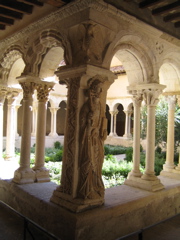
We waited a while for a funeral to finish before the cathedral was open, but it was well worth waiting. The main building is big and beautiful with stained glass. We were given a guided tour of the lovely cloisters - the guide told us a great deal of old and new testament history and interpretation in order to explain the carvings on the heads of the columns.
We walked up and down the Cours Mirabeau - the 'ramblas' of Aix. It is lined with plane trees giving plenty of shade and is punctuated by fountains and sculptures. To our disappointment, the tourist office confrmed that no works by Cézanne are in galleries in Aix, but they recommended an evening show in the garden of Cézanne's former house and atelier. After a meal in a nearby square, we wondered through the Mazarin area south of Cours Mirabeau - this very smart area of 17th century houses many of which are decorated by fer forgé.
Hotel : Hotel le Manoir.
Distance today 36 kms. Route details - la Tour-d'Aigues – Pertuis – cross Durance – le Puy – Canadet – D13 ( and a hard to find bridge over autoroute) – Aix-en-Provence.
Our photographs of Mont Ste Victoire are available here.
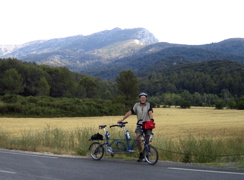 The approaching Bastille day holiday meant that our hotel was fully booked for the second night but they found us a room at the Hotel du Globe nearby. We planned to spend the day on Mont Saintes Victoire – made famous by Cézanne's many paintings of it – returning to the new hotel in the evening. We cycled out on the road to Vauvenergues past the Barage of Bimont, which was built by the father of Emile Zola. We locked the tandem where the GR9 crosses the road and then leads up Mont Ste. Victoire. This path goes through pine woods, about half way up you catch sight of the priory and the cross at the top. It looks almost impossible to get up there, but the zig-zag path is good. The old priory at 900m was built in 1690 - it still has a little chapel and people presumably walk up there to pray.
The approaching Bastille day holiday meant that our hotel was fully booked for the second night but they found us a room at the Hotel du Globe nearby. We planned to spend the day on Mont Saintes Victoire – made famous by Cézanne's many paintings of it – returning to the new hotel in the evening. We cycled out on the road to Vauvenergues past the Barage of Bimont, which was built by the father of Emile Zola. We locked the tandem where the GR9 crosses the road and then leads up Mont Ste. Victoire. This path goes through pine woods, about half way up you catch sight of the priory and the cross at the top. It looks almost impossible to get up there, but the zig-zag path is good. The old priory at 900m was built in 1690 - it still has a little chapel and people presumably walk up there to pray. 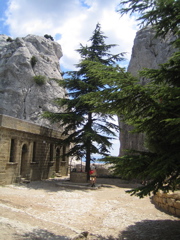 The remainder of the premises are used as a simple (unmanned) refuge, In the yard is a well with non-drinkable water. There are good views in both directions down the two sides of the mountain. There is a sheer drop on the south side. The cross at the top of the mountain can be reached only by anyone who can climb up the big vertical sided rock. We stopped for a picnic on the north side with wide views across to the Luberon. It was a long walk down and once again we got very thirsty having drunk all of our water. We wanted a swim, but the lakes by the barage were strictly no swimming and we didn't dare to try. We stopped at the first bar on the way into Aix.
The remainder of the premises are used as a simple (unmanned) refuge, In the yard is a well with non-drinkable water. There are good views in both directions down the two sides of the mountain. There is a sheer drop on the south side. The cross at the top of the mountain can be reached only by anyone who can climb up the big vertical sided rock. We stopped for a picnic on the north side with wide views across to the Luberon. It was a long walk down and once again we got very thirsty having drunk all of our water. We wanted a swim, but the lakes by the barage were strictly no swimming and we didn't dare to try. We stopped at the first bar on the way into Aix.
After a shower and a rest, and a meal in a square near the town hall, we walked up the hill out of the town centre to the atelier of Cézanne to see the evening show in his large garden. 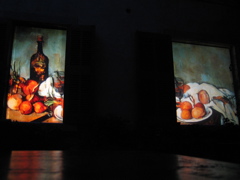 The light show started at 9.30 as it got dark. A set of projectors scattered about the garden were used to project the paintings. The still lives and portraits were projected onto two ground floor windows, then figures in landscape on a screen on one terrace and the Mont St. Victoire pictures on another terrace. This is a lovely garden with many pine trees and several different levels. One of the projections was close to a small pool and the water in the pictures was somehow merged with apparent reflections from the real water. A slide show in a little conservatory quoted Cézanne's words and tried to analyse the pictures - but it also displayed them in a rather broken-up manner, which was annoying. This show was arranged by Gianfranco Ianuzzi who also designed the cathedral of images at les Baux (which we passed by but didn't visit).
The light show started at 9.30 as it got dark. A set of projectors scattered about the garden were used to project the paintings. The still lives and portraits were projected onto two ground floor windows, then figures in landscape on a screen on one terrace and the Mont St. Victoire pictures on another terrace. This is a lovely garden with many pine trees and several different levels. One of the projections was close to a small pool and the water in the pictures was somehow merged with apparent reflections from the real water. A slide show in a little conservatory quoted Cézanne's words and tried to analyse the pictures - but it also displayed them in a rather broken-up manner, which was annoying. This show was arranged by Gianfranco Ianuzzi who also designed the cathedral of images at les Baux (which we passed by but didn't visit).
Hotel : Hotel du Globe.
Distance today 27 kms. Route details - Aix-en-Provence – (D10) almost to Vauvenargues rerning the same way.
Our photographs of Silvacane and Ansouis are available here
We decided to use our return journey to visit several more of the interesting villages in the Luberon. The ride out of Aix via Eguilles was more pleasant than the way we came in - wooded most of the way, hence shade. Our first stop was at Rognes an attractive old village where we had a coffee, bought fruit and bread. Then as it was Bastille Day everyone was on holiday and a small jazz group started to play in the square. 
We went north towards the Durance passing by the Bassin de St Christophe a big reservoir (not sure where the water comes from) which leads into a canal that supplies water to Marseilles. Unfortunately, once again, no swimming.
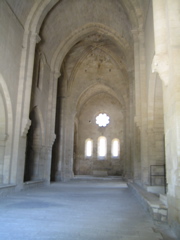 We visited the Abbaye of Silvacane a 12th century cistercian abbey.The main church is big, beautiful and very austere - as are all Benedictine monasteries apparently, in reaction to the ecclesiastical excesses of the time. The stones are perfectly cut but quite rusticated. The monks quarters are next door, there is a big dormitory upstairs, a chapter house (where they heard one chapter of St. Benedict each day). Then some very nice clositers. We picnicked in a shady spot in the grounds.
We visited the Abbaye of Silvacane a 12th century cistercian abbey.The main church is big, beautiful and very austere - as are all Benedictine monasteries apparently, in reaction to the ecclesiastical excesses of the time. The stones are perfectly cut but quite rusticated. The monks quarters are next door, there is a big dormitory upstairs, a chapter house (where they heard one chapter of St. Benedict each day). Then some very nice clositers. We picnicked in a shady spot in the grounds.
This time we crossed the Durance at the bridge on the road to Cadenet and this crossing was much more pleasant than either of the other bridges we had used. We didn't have the energy to go to Cadenet, which looked promising, so took minor roads into Ansouis. Ansouis is another perched village and is said to be one of the best in the Luberon. Crowning it all is a big castle - actually two castles (one renaissance and the other mediaeval) and a church. We went on a guided tour through many rooms, even seeing the old kitchen used by the current vicomte who lives in the castle. After an ice cream we returned to our gite for an evening meal.
When it got dark we went back into Tour d'Aigues to see the fireworks which were set off from inside the ruined chateau - a spectacular site with red light and smoke emerging from the buildings. People from all round came into the town and filled up all available seats and standing room. Fortunately we were early and had a good seat in the cafe opposite the chateau.
Distance today 56 kms . Route details - Aix-en-Provence – Eguilles – Rognes Silvacane – D37 – Ansouis – D135 – la Tour d'Aigues
 This being our last day in the gite, we decided to stay in the area. In the morning we went to visit the chateau which was built in the 16th century and even now, as a ruin is impressive - it was damaged by a fire and repaired and then almost completely ruined during the revolution. We were able to walk round the remains of the buildings and to go into the ceramics museum in the remaining part of the chateau. Judging by the ceramics on show, la Tour d'Aigues was a flourishing centre for production of beautifully glazed and coloured plates and dishes. The basketwork section of the musem showed modern models of objects made from willow sticks throughout history back to the Roman times.
This being our last day in the gite, we decided to stay in the area. In the morning we went to visit the chateau which was built in the 16th century and even now, as a ruin is impressive - it was damaged by a fire and repaired and then almost completely ruined during the revolution. We were able to walk round the remains of the buildings and to go into the ceramics museum in the remaining part of the chateau. Judging by the ceramics on show, la Tour d'Aigues was a flourishing centre for production of beautifully glazed and coloured plates and dishes. The basketwork section of the musem showed modern models of objects made from willow sticks throughout history back to the Roman times.
In the courtyard of the chateau we came across a very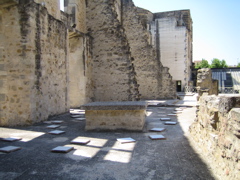 interesting installation (photo right) - 'walking music' there are discs on the ground as as you pass by certain points (presumably with detectors, but we couldn't spot them), music starts to play softly. Quite subtle and very interesting, we spent some time wondering around and activating the music.
interesting installation (photo right) - 'walking music' there are discs on the ground as as you pass by certain points (presumably with detectors, but we couldn't spot them), music starts to play softly. Quite subtle and very interesting, we spent some time wondering around and activating the music.
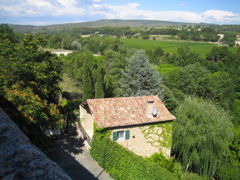 In the afternoon we did one of the 'walks through the vineyards of the Luberon' recommended by the tourist office. It started just up the road from the gite and wound round on small roads with vineyards on each side, eventually arriving at the little river Eze below the chateau at la Tour d'Aigues. It then zigzagged up the steep path below the chateau and out onto the big terrace in front of the chateau.
In the afternoon we did one of the 'walks through the vineyards of the Luberon' recommended by the tourist office. It started just up the road from the gite and wound round on small roads with vineyards on each side, eventually arriving at the little river Eze below the chateau at la Tour d'Aigues. It then zigzagged up the steep path below the chateau and out onto the big terrace in front of the chateau.
By now the gite owners (Jean-Louis and Simone Pascal) had returned home and they presented us with three bottles of local Luberon wine (la Tourel), one red, one rosé and one white. They didn't say, but it may have been compensation for the fact that their dog had eaten not only Jean's shoes, but also our plastic water bottle.
 Xavier arrived very early to collect us and we took the tandem apart and the three pieces fitted nicely into the Renault Kangoo. We were driven via Manosque, Sisteron and Gap to our friends' house at Pont Manel near Chauffayer. As these pages are about a cycling trip and the stay at Pont Manel was a private, family affair, we will be brief.
Xavier arrived very early to collect us and we took the tandem apart and the three pieces fitted nicely into the Renault Kangoo. We were driven via Manosque, Sisteron and Gap to our friends' house at Pont Manel near Chauffayer. As these pages are about a cycling trip and the stay at Pont Manel was a private, family affair, we will be brief.
Staying with friends in Chauffayer, near St. Bonnet until Wednesday night.
Our photographs of Valgaudemar are available here
On previous visits to Pont Manel we have been to Valgaudemar, probably the most beautiful mountain valley that we have seen anywhere. 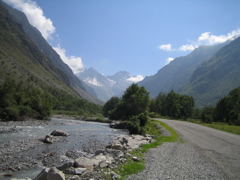 This time we explored it by cycle, avoiding as far as possible the N85 that links Grenoble and Gap. Small roads took us to l'Allée at the foot of the valley, here there are roads on either side of the river Severaisse. We took the smaller one on the south side and rode through the small villages getting glimpses of the fast running river and passing through fields and copses of birches and larches. On both sides, the big mountains towered above us. At the head of the valley we caught glimpses of the peaks of Sirac and Olan. La Chapelle is the last village as you mount the valley, although there are many tourists there, the atmosphere is pleasant and it has plenty of resources. The road continues in the valley a few kilometers above La Chapelle and then goes up the side of the hill to the refuge of Giobernet. We locked up the tandem where the road climbs steeply and walked on a lower-level path along to the end of the valley where the path up to the refuge of Vallonpierre starts.
This time we explored it by cycle, avoiding as far as possible the N85 that links Grenoble and Gap. Small roads took us to l'Allée at the foot of the valley, here there are roads on either side of the river Severaisse. We took the smaller one on the south side and rode through the small villages getting glimpses of the fast running river and passing through fields and copses of birches and larches. On both sides, the big mountains towered above us. At the head of the valley we caught glimpses of the peaks of Sirac and Olan. La Chapelle is the last village as you mount the valley, although there are many tourists there, the atmosphere is pleasant and it has plenty of resources. The road continues in the valley a few kilometers above La Chapelle and then goes up the side of the hill to the refuge of Giobernet. We locked up the tandem where the road climbs steeply and walked on a lower-level path along to the end of the valley where the path up to the refuge of Vallonpierre starts.
Today there was a strong SW wind, which helped us as we climbed the valley and didn't do much to slow us as we came back down. In fact, the weather is now much cooler here at the 900m level.
Our photographs of Nyons and Orange are available here
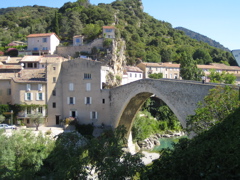 We were sorry to leave our friends, but we were due to go off to catch the bike express. The tandem was disassembled and stowed in the Kangoo and delivered with us to Nyons, passing through the hills and valleys of the Drome region and the spectacular gorges of St. May.
We were sorry to leave our friends, but we were due to go off to catch the bike express. The tandem was disassembled and stowed in the Kangoo and delivered with us to Nyons, passing through the hills and valleys of the Drome region and the spectacular gorges of St. May.
We put the tandem together again watched by a class of schoolchildren, said farewell to Xavier and set off to look around Nyons, a small market town having its market day, so very busy and loaded with tourists. The market occupied not only the central square with its arcades, but also most of the narrow streets as far as the renaissance bridge over the river Eygues. 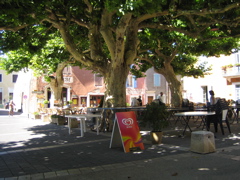
Our route to Orange followed the river Eygues and took us through landscape made beautiful by the many olive trees, all of them standing on their rootes above the ground. As we had plenty of time, we stopped for a coffee in the walled village of Villedieu with its big square made shady by giant plain trees. We bought food for lunch and then went on in an increasing mistral wind – the strongest we had encountered – deciding to stop for a picnic at Camaret; we thought the small walled area of the old town there was all there was and sat on the ground by the church for our picnic. However, other cyclists later told us the town extended on the far side. It was only a short ride into Orange and we arrived spot on for the Roman theatre.
 Orange was just clearing up after a market and the tourist office refused to guard our baggage (might contain bombs), but told us the reception at the Roman theatre would do so. We went first to see the Roman Arc de Triomphe at the entry to the town - it is enormous and some of the original carvings are still in good order.
Orange was just clearing up after a market and the tourist office refused to guard our baggage (might contain bombs), but told us the reception at the Roman theatre would do so. We went first to see the Roman Arc de Triomphe at the entry to the town - it is enormous and some of the original carvings are still in good order.
When George was trying to lock up the bike, it blew over and the sharp parts hit him on both legs, but he managed to recover soon.
Then we went to look over the Roman theatre - they are very proud that the high stage wall is still pretty well intact with its big carving of the emperor whose head could be changed to match each new incumbent - the emperors were pretty much gods. The semi-circular rows of stone seats could seat 7000 spectators with the most important people at the bottom and the least at the top. It was a long hot climb up, but worth it, for the view of the theatre and of the town behind it. Here as at most of the other sites we had visited, we were provided with excellent 'audio guides' that allow you go on to the next number on the site and the press a button to hear the infomation about it - the guides are available in most languages.
The museum opposite the theatre contains (amongst other things) some roman land registries (called cadastres), made on very large squares of stone. Each stone square refers to an area of the town, and records the name of the owner of each small square of land.
The town square was an excellent place to sit and wait until it was time to go for the coach, which very conveniently does its pick-up at an autoroute péage really close to the town - much easier than the usual ride out to commercial zone well ouside the town, though maybe it's bad luck for the inhabitants of Orange to have the péage so close to town.
At the pick-up point we met up again with a couple of friends we had met on the outward journey – they seemed to have ridden up half the cols in the alps on their bikes since we last saw them. The coach turned up almost on time and we were lucky enough to get the table seats again and a reasonably comfortable trip home.
Route details- lift by car to Nyons. Nyons – Camaret – Orange.
Total distance approximately 700 kms.